Uzbek Food Dishes: Basic Overview
Common Ingredients
Common Cooking Methods
Courses
Meals
Key Taste
Eating Etiquette
Meal Presentation
Culinary Festivals
Influence and Fusion
Popular Types of Uzbek Dishes
-
Rice Dishes
In Uzbek cuisine, rice dishes are central, featuring rice cooked with a mix of meats, vegetables, and spices.
They are often served as the main course and celebrated for their rich flavors and communal serving style.
-
Bread and Doughs
Uzbek breads are fundamental to every meal.
They are baked in clay ovens and enjoyed for their chewy texture and versatility.
-
Dumplings
Uzbek dumplings are beloved for their delicate wrappers filled with spiced meats and vegetables.
-
Desserts
Desserts in Uzbekistan range from sweet confections offering a variety of flavors.
Uzbek dishes are specialties commonly enjoyed by the people of Uzbekistan. They share many similarities with the food offerings of neighboring Central Asian countries, such as Kazakh specialties.
In addition, dishes in Uzbekistan are also influenced by Persian (Iranian), Ottoman (Turkic), Arab, Uyghur, and Russian food offerings due to the nation’s rich history.
Wheat production is extensive in Uzbekistan, so wheat flour-based foodstuffs like bread and noodles are essential staples. Similarly, this Central Asian country has a great deal of cattle farming, making meat the dominant source of protein.
Mutton is the most abundant type of meat thanks to the large size of sheep flocks. Beef, horse meat, and chicken are also popular. Since Uzbeks are mostly Muslim, meat varieties like pork are uncommon.
Seasonal fruits and vegetables are other vital food ingredients in Uzbek cuisine. Cooking fats (like lamb fat) and dairy products (such as yogurt) are ubiquitous.
People in Uzbekistan also share the Russian fondness for sour cream. Rice is used chiefly in the country’s national dish, plov.
Many areas in Uzbekistan are famous for mouth-watering regional specialties, like Samarkand (the oldest city in Central Asia) and Bukhara (an ancient city noted for its local Jewish cuisine).
I will give you the fundamentals of Uzbek cuisine, such as the main reasons behind its fame, along with some drink pairings to have with dishes.
20 Popular Uzbek Dishes with Filters
While doing your reading, use the filter system to reorganize the dishes in alphabetical order, dish types, tastes, key ingredients, cooking methods, and global popularity.
Plus, you shouldn’t miss the culinary styles of Uzbek food, featuring choices like the most popular, national, traditional, and street food:
Plov
- National
- Traditional
Plov, also known as palov or osh, is among the most famous Uzbek national foods made by simmering rice in a rich stew with meat and vegetables. It’s usually cooked in a kazan, a type of wok-shaped cooking pot popular in Central Asia.
The mixed rice dish is so important to Uzbek food culture that the making of plov was recognized as the country’s UNESCO Intangible Cultural Heritage of Humanity in 2016.
Typical ingredients for plov include beef or lamb, carrots, onions, garlic, and spices like cumin and chili peppers. Some regional versions have sweet or nutty flavorings, like dried fruits, sesame seeds, or melon seeds.
Nahor oshi, also known as morning plov, is served in the morning at large celebrations. Osh palov (made with beef or chicken) and bakhsh (green plov) are two distinct versions belonging to the Jewish communities in Bukhara.
Lagʻmon
- Traditional
Lagʻmon, or laghman, is a top-rated noodle dish in Uzbek cuisine. Derived from Uyghur cuisine in China, lag’mon consists of chewy hand-pulled noodles, mutton or beef, vegetables (like potatoes, onions, tomatoes, and carrots), and assorted spices.
The noodle dish is available in two versions: noodle soup and stir-fry, with the former being served in an aromatic meat broth.
Among the best Uzbek noodle variants, shivit oshi from the city of Khiva stands out because of its unique green color. Shivit oshi is topped with beef stew and tangy yogurt.
Somsa
- Street Food
- Traditional
Somsa, or samsa, is a traditional Uzbek food, featuring a baked bun stuffed with spiced meat and vegetables. Lamb and onions are the classic ingredients, though beef, chicken, pumpkins, and potatoes are sometimes used.
Locals usually have it as an appetizer, snack, or main dish. In Uzbekistan, the savory pastry is available at countless roadside food carts and kiosks as a hot street food.
Somsa pairs well with tea, the most popular beverage in the nation. The baked bun strongly resembles samosas in South Asian cuisine, but it is cooked by baking in a clay oven, not fried like samosas.
Manti
- Traditional
Manti, also known as kaskoni, is a popular type of dumpling in Uzbek cuisine. Its name suggests a close relation to mantou (Chinese steamed bun), which is very likely an inspiration for the dumpling dish.
People in Uzbekistan prepare manti by wrapping thin dough sheets around a mixture of spiced mutton or beef, potatoes, pumpkins, and cabbage.
The dumplings are then steamed before being served with butter, onion slices, ketchup, sour cream, or a dipping sauce made from chili powder and vinegar.
Chuchvara
- Traditional
Chuchvara is a Uzbek dumpling dish usually served in a clear soup or a vinegar- or tomato-based sauce. The dish is the local interpretation of joshpara, a type of West Asian and Central Asian dumpling.
Compared to other dumpling varieties beloved by Uzbeks, chuchvara is smaller and always made with wheat dough squares. Its filling consists of minced meat, onions, and spices like black pepper and thyme.
Sour cream or suzma (strained yogurt) are ideal sides for the dumpling dish, which is sometimes served in soup or broth. Besides the traditional soupy version, chuchvara is sometimes pan-fried to create qovurma chuchvara.
Shurpa
- Traditional
Shurpa, also spelled as shurva or shorva, is a sought-after soup made from fat lamb cuts, vegetables, and plenty of spices in Uzbekistan.
The soup is extremely rich and thick, with onions, carrots, and tomatoes as the favorite veggies. Depending on the seasons, other options like turnips or bell peppers are occasionally used.
The idea behind shurpa comes from chorba, a large group of savory soups and stews in Persian and Turkish cuisines.
Dimlama
- Traditional
Dimlama, or dymdama, is a favorite Uzbek stew made from large meat chunks and assorted vegetables. While mutton and beef are the traditional choices of meat, potatoes, cabbage, and carrots are ideal options in terms of vegetables.
The meat and vegetable stew is widely available during the harvest season, especially in spring and summer when seasonal vegetables are hugely abundant.
Kebab
- Street Food
- Traditional
Kebab, or kabob, is a renowned Uzbek dish and street food made from grilling meat on skewers. The most favorite variation in this country is shish kebab, sometimes known as shashlik.
The default choice of meat for Uzbek-style kebabs is lamb, though beef and, to a lesser extent, horse meat are also used.
Locals marinate big meat chunks in a simple marinade of sliced onions, black pepper, coriander, and other spices, then grill them with cubes of lamb fat to create a distinctly rich flavor.
Obi Non
- Traditional
Obi non is a classic flatbread paired with many popular Uzbek foods, from stews to grilled meat. Known as tandyr nan in many Central Asian countries, obi non has a thick, round, disc-like shape and a chewy texture.
The thick flatbread is pressed down in the middle and decorated with many patterns by using a chekich (bread stamp). Obi non is typically made from a plain dough of just wheat flour before being cooked in a type of clay oven called tandir (or tandoor).
During Uzbek engagement ceremonies, the two families often split giant loaves of bread to symbolize the unity between the two sides. This practice is called non sindirish (breaking bread).
Naryn
- Traditional
Naryn, alternatively known as beshbarmak, is a prominent dish made from shredded horse meat and hand-pulled noodles in Uzbek cuisine. This pasta dish also features onions, kazy (horse meat sausage), and a meat broth.
The noodle dish with horse meat is usually eaten with hands and is excellent whether enjoyed hot or cold. Folks in Uzbekistan and neighboring Central Asian countries usually serve it on large communal platters after samba or shurpa and before plov.
Oshi Toki
- Traditional
Oshi toki, or stuffed grape leaves, is the famous Uzbek take on the Ottoman dish dolma. There is even a palov variant called kovatok palov that serves stuffed grape leaves on the bed of broth-cooked rice.
To prepare oshi toki, people wrap grape leaves around a filling of spiced minced lamb and rice. Next, the rolls are cooked in oil with bay leaves and sautéed onions until soft and fragrant.
Suzma
- Traditional
Suzma is a famous dairy product served as a food ingredient or side dish with many Uzbek specialties. The creamy yogurt is made by draining qatiq (a type of full-fat yogurt) for hours, creating a tangy and creamy product.
Milk from sheep, horses, or cows is the usual ingredient for making suzma. The strained yogurt pairs perfectly with manti, bread, salads, and many other foods.
Some people also use it to make ayran, a renowned yogurt-based drink in Uzbekistan. When suzma is left to dry, it becomes qurt, a type of dry fresh cheese sold as chunks, balls, or slices.
Shakarap
- Traditional
Shakarap is a sought-after Uzbek salad made from tomatoes, onions, dill, basic seasonings, and vegetable oil for the dressing. The salad is mainly available in spring and summer when the vegetables are at their best.
Locals frequently enrich the tomato salad with red radishes, green chilies, and even white yogurt to add more colors and flavors. The fall version of shakarap even includes a pumpkin filling.
Chalop
- Traditional
Chalop, or chalap, is a celebrated Uzbek yogurt soup made from suzma or qatiq and vegetables like dill, cucumbers, parsley, and radishes. Its taste profile is as rich and diverse as salted cheese.
The cold yogurt soup is a perfect starter before the savory dishes in Uzbek cuisine. Its light and refreshing taste is delightful in summer.
Nawat
- Traditional
Nawat, or novvot, is an ubiquitous Uzbek sweet made of crystallized sugar and usually enjoyed with green tea or black tea.
Folks in Uzbekistan prepare nawat by cooking sugar syrup or grape juice with spices (like saffron and cardamom) in a large cauldron until sugar crystals form and solidify. Depending on the ingredients, nawat ranges from light yellow to deep amber in color.
Halva
- Traditional
Halva is a well-liked confection with many variations in Uzbekistan. The most popular ingredient for halva is sesame paste, though there are several versions made with wheat flour.
Sesame oil, sugar syrup, chopped nuts, vanilla beans, sunflower seeds, and cacao powder are classic flavorings.
The confection is always full of sweet, nutty, and toasty goodness, a wonderful flavor to go with tea and coffee. Samarkand halva is a famous regional variant widely available at local markets like Chorsu Bazaar and Siab Bazaar.
Sumalak
- Traditional
Sumalak is a famous Uzbek sweet made from wheat flour and germinated wheat (young wheatgrass). Created in ancient Persia, sumalak is a must-have food offering for Nowruz (Persian New Year), a major holiday that marks the beginning of spring.
The basic concept for making sumalak is to slow-cook the main ingredients in olive oil and water for hours until the mixture becomes thick, sticky, and deeply brown.
Traditionally, only elderly ladies prepare the germinated wheat sweet, as the process takes all night and spans into early morning hours.
The process is accompanied by a lot of dancing and singing. There is a myth that your wish will come true if you make a wish on your first sumalak try!
Tirit
- Traditional
Tirit is a dish of Uzbekistan that locals prepare by putting bread crumbs in a broth made from lamb offals. The bread and offal broth dish is then garnished with onions, ground pepper, and yogurt (optional).
Popular across Central Asia, tirit is an economical dish that helps clean up leftover bread and meat. People sometimes replace the offal broth with qovurdoq, a dish of fried lamb and onions.
Samarkand Non
- Traditional
Samarkand non is a celebrated type of bread that originated in the city of the same name. The bread has the same shape and patterned top as common oshi toki variants, but it is typically larger and has a softer crust.
The fantastic bread from Samarkand boasts an excellent shelf life of up to 10 days. Various traditional Uzbek dishes and condiments go well with the bread, from plov to salads and yogurt.
The best place to try Samarkand non is naturally Samarkand, with more than 15,000 loaves of Samarkand baked every day. There’s even a legend saying that it is the air of Samarkand that makes this bread incredibly tasty.
Chicken Tabaka
- Traditional
Chicken tabaka is a popular pan-fried chicken dish in Uzbek cuisine. Though created in Georgia, chicken tabaka found its way to the Central Asian country when both nations were part of the Soviet Union.
Locals prepare chicken tabaka by butterflying (splitting in half but not completely through) a whole chicken, opening up the two halves, marinating them in a simple spice mix, then frying them until golden and crispy.
While lamb and beef are the two most popular meat types in Uzbekistan, chicken tabaka shows that poultry is also a great food ingredient, adding the flexibility that makes local cuisine so popular.
Why Are Uzbek Dishes Well-Known?
The following 5 factors contribute to the popularity of Uzbek dishes: historical ingredients, communal spirit, natural ingredients, and Bukharan Jewish cuisine.
| Factor | Details |
|---|---|
| Historical Ingredients | Uzbek dishes incorporate ingredients that have been used for centuries, reflecting the country’s rich history. |
| Communal Spirit | Meals are often enjoyed in large gatherings, emphasizing the importance of sharing and community in Uzbek culture. |
| Natural Ingredients | Fresh produce, herbs, spices, meat, and dairy are fundamental, contributing to the dishes’ richness and savoriness. |
| Bukharan Jewish Cuisine | The culinary traditions of Bukharan Jews add creativity and variety to Uzbekistan’s food landscape. |
| Country Influences | Persian, Arab, Ottoman, Uyghur, and Russian cultures, along with dishes from neighboring Central Asian countries, have shaped Uzbek cuisine. |
While Uzbekistan has several noted regional cuisines, the traditions of Bukharan Jews are highly influential and impart a lot of creativity to common kinds of foods in Central Asian countries.
To add to that, Uzbek dishes even pair well with many drinks to improve the overall experience.
What Uzbek Dishes to Have with Beverages?
Pairing Uzbek dishes with drinks of Uzbekistan involves considering the rich flavors and ingredients typical of the cuisine. Here are some general suggestions:
Don’t forget to like and share these Uzbek dishes with people you know so they too, have a better understanding of Uzbek cuisine. Plus, you should drop a comment sharing your thoughts about Uzbek dishes.















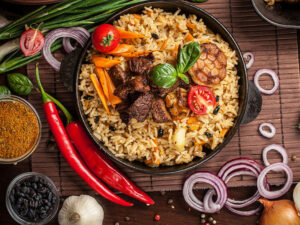
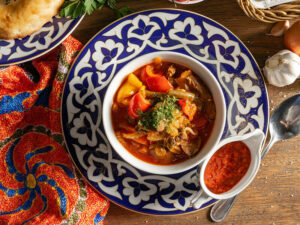
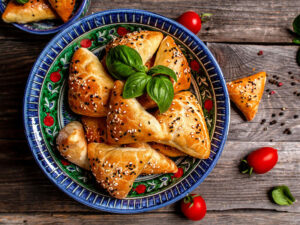
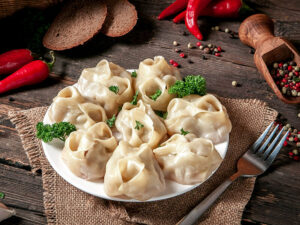
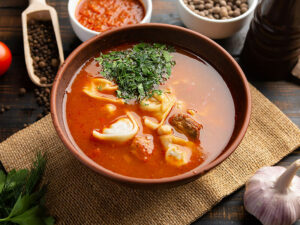
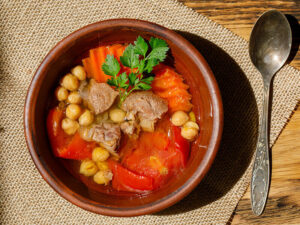
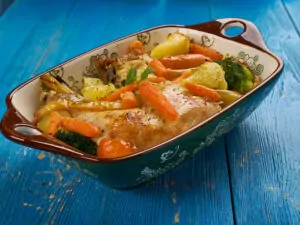
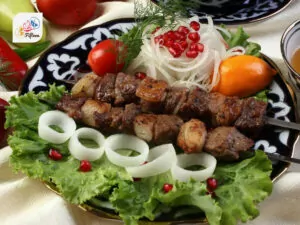

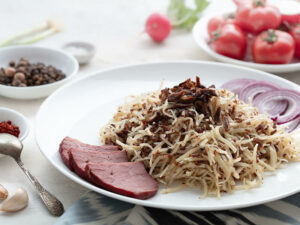
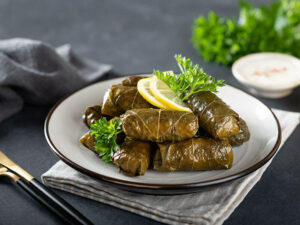
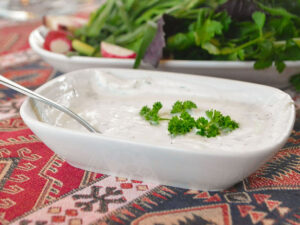
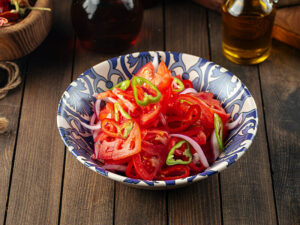
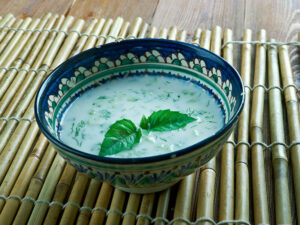
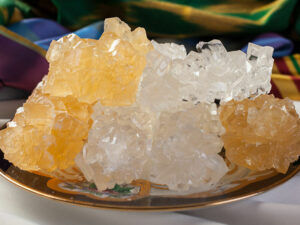
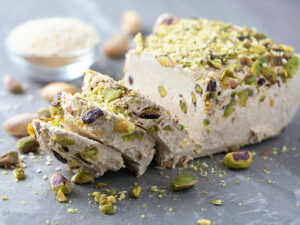
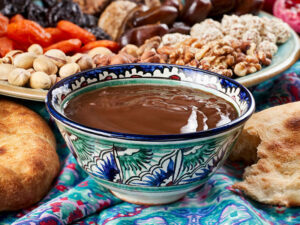
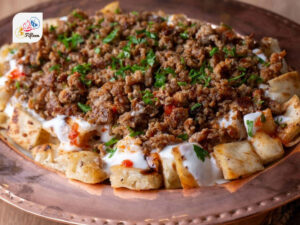
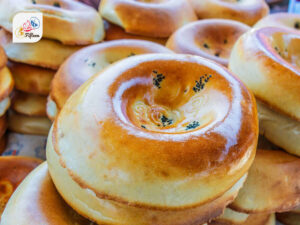
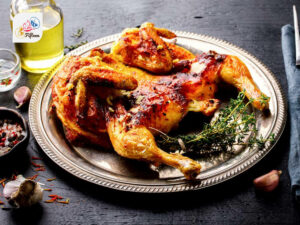
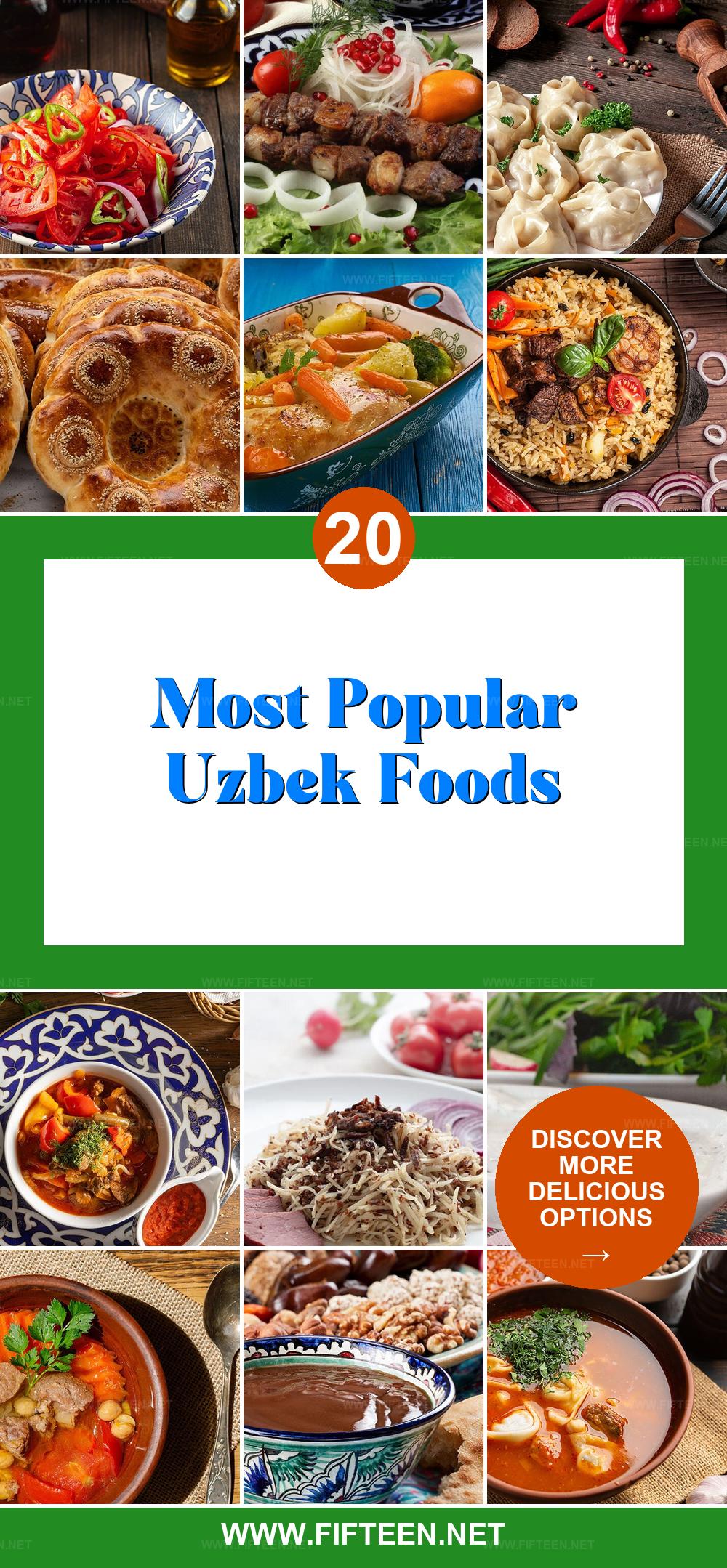
Jamie Scott
Editor in Chief, Senior Content Writer
Expertise
Home Cooking, Meal Planning, Recipe Development, Baking and Pastry, Food Editor, Cooking-video Maker, Western Food Evaluation Expert
Education
Le Cordon Bleu College of Culinary Arts
Local Community College, New York, NY
Jamie Scott is a skilled culinary expert and content creator specializing in Western cuisine. With over 15 years in the culinary field and formal training from Le Cordon Bleu, Paris, Jamie deeply understands how to blend nutrition with delicious flavors. His passion for cooking matches his commitment to making healthy eating accessible and enjoyable.
On Fifteen.net, Jamie brings a fresh perspective to classic dishes and beverages, offering readers insightful recipes, cooking tips, and a fresh view on meal planning that emphasizes taste, health, and simplicity.